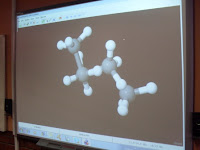Tuesday, October 18, 2011
Skills Transfer Program
Monday, September 26, 2011
Onscreen Marking
The assignment that is submitted must be in Adobe pdf format. Teachers can then mark the assignment in various ways. If they click on the calculator the program adds up the mark. Comments can be made on the assignment and mailed back to the student with the teacher keeping an electronic copy.
Some people may not agree with some of the marking methods, but it a useful tool.
For more details go to http://bit.ly/camn1X.
Microsoft Education Labs
You light up my life...
 A few days ago I visited Uxolo High School and was stopped by the most gentlemanly Physics teacher that I know, Mr Mathungana. Last quarter he begged me to come to his school and install Science Freeware for him. I did this and did a quick training session with him. This took place amongst a number of disruptions as different people vied for his attention.
A few days ago I visited Uxolo High School and was stopped by the most gentlemanly Physics teacher that I know, Mr Mathungana. Last quarter he begged me to come to his school and install Science Freeware for him. I did this and did a quick training session with him. This took place amongst a number of disruptions as different people vied for his attention.Mr Mathungana explained to me how he used the PhET simulations (http://phet.colorado.edu) of the Photo-electric effect and waves in his teaching. He explains to learners and they visually see the concepts which otherwise they would have to imagine. Change a value here and there and the investigative process starts. What if..? What is our hypothesis? Instead of getting apparatus together we can use the simulations. Do we have an answer. Does it confirm or refute our hypothesis?
On the same day at Intlanganiso I observed Mr Yali teaching a grade 9 class transformations in Mathematics on the Interactive Whiteboard. He had Master Maths (http://www.mastermaths.co.za) open going through a few slides, explaining each step of the problem. There was a set of axes a one point plotted. The program asked for a reflection of that point about the x - axis. The learner came to the board and clicked the wrong answer. The program responded. Mr Yali picked up the Interactive Active Whiteboard pen and wrote over the program on the the board. He knows his stuff with Maths and with ICT.
Was our time wasted in schools? I don’t think so. To these teachers who are working hard at getting learners to do well in Physics and in Maths, you’re the best.
Thursday, September 22, 2011
Skills Transfer Session 8
Principal : Mr S. Maqhubela



 This ceremonious event took place at the premises of the Lwandle Primary school on the 17 August 2011. The main objective behind the launch was to notify all relevant stakeholders about existence of the two main information centres that are now officially in operation. Launching these two information Centres was paramount as it was through collaboration and efforts of the stakeholders. Furthermore, learners needed to be made aware that the library and Computer lab work reciprocally to uplift learning and teaching.
This ceremonious event took place at the premises of the Lwandle Primary school on the 17 August 2011. The main objective behind the launch was to notify all relevant stakeholders about existence of the two main information centres that are now officially in operation. Launching these two information Centres was paramount as it was through collaboration and efforts of the stakeholders. Furthermore, learners needed to be made aware that the library and Computer lab work reciprocally to uplift learning and teaching.  The WCED (represented by Ms K. Mabandla) and Khanya Project (represented by B. Hendricks and S. Didiza) were the main official representatives who made the existence of the school library and Computer centre possible for our learners. The WCED efforts started when Ms K. Mabandla visited the school to meet our school library coordinator. The school coordinators keenly consulted all school structures (Principal, educators, School Governing Body and broader parent community). Parents never wasted time as they saw the initiatives will benefit their learners. Learners will definitely improve the level of reading, writing and numeracy. There were other partners (i.e. Equal Education and Rotary Club) in education who primarily help schools from the disadvantaged community. They indicated from their speeches that they would like to see the centres used profitably for the best interest of learners so that in the end they (learners of the school) are on par with other well-off learners in well-resourced schools. A number of representatives from various neighbouring schools were in attendance also to witness the event. Both rooms were resourced satisfactorily but space for books and other equipment is vast and the school will appreciate assistance from any organization.
The WCED (represented by Ms K. Mabandla) and Khanya Project (represented by B. Hendricks and S. Didiza) were the main official representatives who made the existence of the school library and Computer centre possible for our learners. The WCED efforts started when Ms K. Mabandla visited the school to meet our school library coordinator. The school coordinators keenly consulted all school structures (Principal, educators, School Governing Body and broader parent community). Parents never wasted time as they saw the initiatives will benefit their learners. Learners will definitely improve the level of reading, writing and numeracy. There were other partners (i.e. Equal Education and Rotary Club) in education who primarily help schools from the disadvantaged community. They indicated from their speeches that they would like to see the centres used profitably for the best interest of learners so that in the end they (learners of the school) are on par with other well-off learners in well-resourced schools. A number of representatives from various neighbouring schools were in attendance also to witness the event. Both rooms were resourced satisfactorily but space for books and other equipment is vast and the school will appreciate assistance from any organization.Music, dance and poetry characterized the jubilation of learners and visitors during this event.
Reported by Sipho Didiza
Friday, August 26, 2011
Skills Transfer Talking Stories Session 6
Friday, August 12, 2011
Skills Transfer Session 5
2. Reading speed determination – Sipho
3. Reading Activities – Comprehension + Flash reading
6. Spelling – Speed test & Create own Spelling list - Siki
8. Basic English- Steward
9. Blogging- Bonny


2. Physics integration with IWB usage. Mark
3. Maths integration with IWB usage. Faeeza
Sunday, July 31, 2011
Did you know?
 Did you know that Butane is a gas sold bottled as a fuel for cooking and camping? If not, then you should. When it is blended with some other hydrocarbons such as propane, it is generally called liquified petroleum gas or LPG for short. We also use it as one component of petrol.
Did you know that Butane is a gas sold bottled as a fuel for cooking and camping? If not, then you should. When it is blended with some other hydrocarbons such as propane, it is generally called liquified petroleum gas or LPG for short. We also use it as one component of petrol.Did you know that children learn this in Organic Chemistry in the FET phase? If you have chalk, you can write its structural, condensed and molecular formulae on a chalk board. Then it goes into a book and hopefully the learners will see the pattern of how to learn it properly.
Did you know that learners cannot visualize concepts in Chemistry? How do learners "see" a molecule such as butane? The condensed formula for a molecule of this gas is CH3CH2CH2CH3 and its molecular formula is C4H10 . How does a learner construct this molecule mentally? Using a ball-and-stick model (if available) an educator can give him/her an idea.

Another idea is to do it electronically. Using software a learner can visualize and manipulate the molecule to get a better understanding. Since many schools have laptops, data projectors and Interactive Whiteboards it will be good practice to use it in their Chemistry teaching.
Did you know that the Chemistry mark is brought down by the section called Organic Chemistry? Can we do something about it? YES WE CAN, ELECTRONICALLY!
Maths and Physics Tution with Winter warmth

 During the Winter Vacation two District East facilitators were spending some time with grade 12 learners tutoring Mathematics and Physics. While the days were cold the information was warmly received.
During the Winter Vacation two District East facilitators were spending some time with grade 12 learners tutoring Mathematics and Physics. While the days were cold the information was warmly received.While Faeeza spent t
 ime going through Functions at Kwa
ime going through Functions at Kwa mfundo, Mark was working away in Mechanics at Harry Gwala High School.
mfundo, Mark was working away in Mechanics at Harry Gwala High School.A shortcoming during these sessions was the non-availability of technology. How different it would have been with Interactive Whiteboards, but despite this it was an enjoyable experience.
Friday, July 29, 2011
MEED Skills Transfer Session 4
Participants Maths and Literacy: - GET Foundation Phase/ InerSen, SP, FET Maths, FET Science - 5 FP officials attended.
Cami Presentation
• Welcome & Attendance register:- Bonny Hendricks

• Using the Speed-test – Mental maths- Steward Blick
• Using the interface of Cami Maths and creating an understanding of the way CAMI Maths works – Sipho Didiza
• Using Search tool for activities according to outcomes -Faeeza Farao

* Revision of CAMI Perceptual by working through additional activity – Siki Notshe
• Using Blogging as reflection. Bonny

Thank you for attending.
Thursday, June 30, 2011
Skills Transfer Program Session 3,10 June 2011



- Register users
- Bulk registration of users using csv. File
- Administer student logons, settings and details
- Autopilot
- Generate class list/CAMI Perceptual
![]() Interface of Cami Perceptual and creating an understanding of the way that it works: (presenter Sipho Didiza)
Interface of Cami Perceptual and creating an understanding of the way that it works: (presenter Sipho Didiza)
![]() Activity Demo: (presenter Siki Notshe)
Activity Demo: (presenter Siki Notshe)
Colour:1.4.6
Shape: 2.4.4.1
Spatial:3.4
Association: 4.3.3
Retention:5.6.4.5
Auditory:6.4.3
Quantity: 7.3.5.6
My Body: 8.3.5
![]() FET Master Maths Revision Program – (Faeeza Farao)
FET Master Maths Revision Program – (Faeeza Farao)
Friday, June 17, 2011
Bored with Solomon Qatyana's boards?
 Recently three facilitators visited Solomon Qatyana to get things going at the school who received Interactive Whiteboar
Recently three facilitators visited Solomon Qatyana to get things going at the school who received Interactive Whiteboar ds, Data projectors and laptops.
ds, Data projectors and laptops.After checking the hardware and doing the software installation it was time for a bit of experimentation. Learners were quick to try out writing with coloured pens on the board. Opening up videos and music created great excitement.
Recently the whole staff started with training on how to set up the Interactive Whiteboard and how to use it.
 The theme of integrating technology in their normal teaching practice was the foundation of the training. The facilitators opened Khanya LTSM to give educators a taste of software that can be used to supplement what they were doing. Educators felt positive about including new things in their teaching.
The theme of integrating technology in their normal teaching practice was the foundation of the training. The facilitators opened Khanya LTSM to give educators a taste of software that can be used to supplement what they were doing. Educators felt positive about including new things in their teaching.























